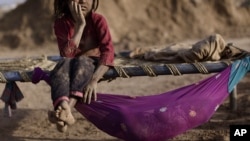GENEVA - The International Labor Organization (ILO) is urging nations to step up the fight against child labor.The ILO is issuing a call to action to mark the 10th anniversary of the annual World Day Against Child Labor on June 12.
More than half of the 215 million child laborers are exposed to slavery and involvement in armed conflict, which the International Labor Organization calls the worst forms of child labor.
About five million children, out of 21 million people globally, are caught in forced labor, including commercial sexual exploitation and debt bondage.
Senior technical specialist Patrick Quinn of the ILO international program for the elimination of child labor says the worst forms of child labor include work that is dangerous to the health, safety and moral development of children.
He says hazardous work, such as mining, agriculture and domestic service is the largest part of the worst forms of child labor.
"The ILO standard on worst forms of child labor was established because we recognize that for many countries, there is a development issue in tackling child labor. We need to improve education. We need to improve social protections systems so that poor families do not have to send poor children to school. We need to provide employment for adults," said Quinn. "So there is an issue about development and tackling the root causes of child labor because fundamental[ly] behind the issue of child labor is poverty -- individual family poverty and societal poverty."
A plan was adopted in The Hague in 2010 to eliminate the worst forms of child labor by 2016. Quinn agrees this target is likely to be missed, especially at a time when countries are cutting back on social provisions.
But he says the challenges are enormous -- not impossible. During the past decade, he notes child labor has been reduced by 20 percent.
He says the greatest progress is seen in Latin American countries, where poor families have been provided with financial incentives to send their children to school.
"But not just in Latin America, we have seen also in some countries in Africa. For example, where governments take steps to abolish school fees, immediately we see a large increase in the numbers of children in school. It is clear that costs are a barrier to many families sending their children to school. So these kind[s] of important policy initiatives are key to tackling the problem," Quinn stated.
Although Kenya, Tanzania and a few other countries have abolished school fees, Quinn says overall the picture of child labor in Africa is not very optimistic. While some progress is being made on the national level, he says child labor in Africa as a whole is increasing.
The International Labor Organization reports the greatest number of child laborers is in South East Asia, but Africa has the highest percentage of those employed in this age group.
The International Labor Organization is calling for nations to strengthen laws aimed at protecting children from exploitation. It also calls for giving all children a quality education, providing poor families with social protection and ensuring adults opportunities for work.
More than half of the 215 million child laborers are exposed to slavery and involvement in armed conflict, which the International Labor Organization calls the worst forms of child labor.
About five million children, out of 21 million people globally, are caught in forced labor, including commercial sexual exploitation and debt bondage.
Senior technical specialist Patrick Quinn of the ILO international program for the elimination of child labor says the worst forms of child labor include work that is dangerous to the health, safety and moral development of children.
He says hazardous work, such as mining, agriculture and domestic service is the largest part of the worst forms of child labor.
"The ILO standard on worst forms of child labor was established because we recognize that for many countries, there is a development issue in tackling child labor. We need to improve education. We need to improve social protections systems so that poor families do not have to send poor children to school. We need to provide employment for adults," said Quinn. "So there is an issue about development and tackling the root causes of child labor because fundamental[ly] behind the issue of child labor is poverty -- individual family poverty and societal poverty."
A plan was adopted in The Hague in 2010 to eliminate the worst forms of child labor by 2016. Quinn agrees this target is likely to be missed, especially at a time when countries are cutting back on social provisions.
But he says the challenges are enormous -- not impossible. During the past decade, he notes child labor has been reduced by 20 percent.
He says the greatest progress is seen in Latin American countries, where poor families have been provided with financial incentives to send their children to school.
"But not just in Latin America, we have seen also in some countries in Africa. For example, where governments take steps to abolish school fees, immediately we see a large increase in the numbers of children in school. It is clear that costs are a barrier to many families sending their children to school. So these kind[s] of important policy initiatives are key to tackling the problem," Quinn stated.
Although Kenya, Tanzania and a few other countries have abolished school fees, Quinn says overall the picture of child labor in Africa is not very optimistic. While some progress is being made on the national level, he says child labor in Africa as a whole is increasing.
The International Labor Organization reports the greatest number of child laborers is in South East Asia, but Africa has the highest percentage of those employed in this age group.
The International Labor Organization is calling for nations to strengthen laws aimed at protecting children from exploitation. It also calls for giving all children a quality education, providing poor families with social protection and ensuring adults opportunities for work.





